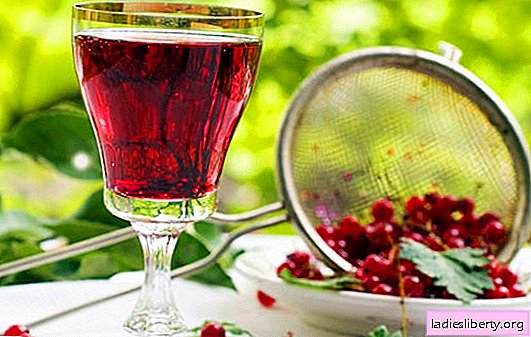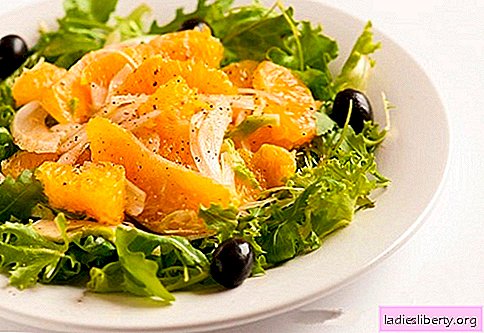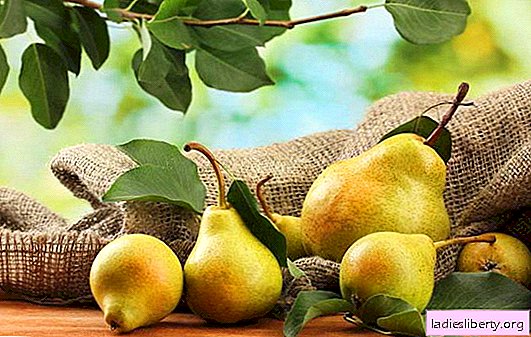
If the beautiful ruby clusters of red currant have pleased with a generous harvest, if the preserves, jams and compotes have already been prepared, and the berries are still left, it's time to start making wine.
Indeed, the wine from these berries can be not only especially beautiful, but also tasty, no less noble than wine from grapes, if it is prepared with love with your own hands.
Redcurrant wine - basic technological principles
Professional winemakers, engaged in the production of grape wines, have long and successfully used a strict algorithm of actions, from harvesting to bottling wines. The same procedure, but when using simpler tools and equipment, must be observed in home winemaking.
Raw material preparation
After collecting and sorting the berries, they are sent under the press to squeeze the juice. On average, from 1 kg of red currant, you can get 600 ml of juice with a simple spin method. There are also two main ways to increase the amount of juice extracted from fruit and berry raw materials.
The first way: the grounds remaining after direct extraction are poured with water, sugar is added, and heated. Then squeeze the liquid and combine it with the juice of the first extraction.
The second way: harvested berries are pressed with sugar and yeast. Raw materials are fermented, as a result of which juice removal improves. After that, wine material is filtered, and solid particles are squeezed out.
If you compare these methods, then for the preparation of red currant wine, it is better to give preference to the second method, since it allows you to get a natural product, but given the following important criteria for evaluating wine material do not rush to conclusions.
Assessment of the chemical composition of the wine material and the preparation of wort for red currant wine
The balanced content of acid and sugar in the fruit juice is the basis of winemaking and obtaining a quality product.
The norm of acid in the finished wine is 0.7%. In natural juice of redcurrant acidity ranges from 1.5 - 4.8% in one liter. As you can see, such a high acid content is far from ideal. Therefore, returning to the methods of obtaining juice, we can say with confidence: no matter how you get juice for red currant juice, adding water to it is inevitable, as this is the only way to regulate the acidity of the wort.
Of course, you need to use prepared water, and distilled water is ideal for wine. It can be easily purchased at any pharmacy. In addition, it is believed that such water contains the least foreign elements for wine that can affect the taste of the drink.
The sugar content is different and much more complicated. Its volume in wine can be different, depending on the type of wine, its strength. But at the stage of preparation of the wort, you still need to adhere to certain standards on which the performance of the yeast and the alcohol content in the wine depend.
The recommended sugar norm in cooked wort is 20% for wine with a strength of 12%. Each added percentage of sugar increases the strength of the wine by 0.6%. But this does not mean that if you need to get wine with a strength of 16%, you need to immediately pour more sugar into the wort. Remember that sugar is used as a preservative in jams because it inhibits the work of yeast and other microorganisms living on the surface of the same fruits that make wine. In addition, to completely stop fermentation in winemaking, sugar is often added to sweet, dessert and liquor wines before sending them for aging.
How to get wine of greater strength? Very simple. You can add the second part of sugar in the period after rapid fermentation, when the yeast has already coped with its initial volume, their colony has grown significantly and an additional portion is needed as a source of their energy. Of course, the fermentation period will increase significantly, but the strength of the future wine will increase.
Sometimes increasing the strength of the wine is achieved by adding alcohol. So they prepare fortified wines, such as Ports, Vermouths. This method is used in the preparation of liquors and liquor wines.
Strong home-made wine cannot be obtained without high-quality wine yeast, while for the manufacture of dry home-made wines, their red currants and other fruits, you can do without wine fermentation.
Speaking of yeast, it is necessary to remember that for successful preparation of wine these microorganisms need a comfortable living environment until the end of fermentation: the optimum temperature is 20-25 degrees, the presence of nutrients and energy that the yeast receives due to the presence of sugar and other elements found in wort composition. As carbon dioxide is released from the liquid during sugar processing and sugar processed by yeast saturates it with alcohol, the wort will turn into a young wine.
Like any living organism, yeast needs oxygen. But as long as the wort turns into wine, the amount that is inside the container and in the liquid itself will be enough. At the end of the fermentation process, the yeast dies and settles to the bottom along with the smallest particles of fruit. This is the essence of fermentation and preparation of wine, and that is why the wort is sealed in bottles with a water shutter, a dowel or an ordinary rubber glove, with a small hole for the gas to escape.
The duration of fermentation can be different. It depends on the temperature, the quality of raw materials and yeast, the type of wine produced. It makes no sense to state the exact date of readiness. A blown-up glove or the cessation of bubbling through a tube connecting the neck of a bottle and cans with water can serve as a signal of the completion of fermentation. But overexposing wine on the lees is extremely undesirable so that it does not become bitter.
As a rule, fruit and berry wines “roam” 1.5-2 months before the stage of young wine, but this period depends on all the factors listed above. Young wine is already suitable for consumption, but before a mature drink he still has to go through several stages:
First, the wine should settle in the bottle in which it “played” until it became transparent and precipitated yeast and insoluble wort microparticles;
After that, the wine is removed from the sediment, tasted;
Depending on the intended variety and taste, the wine is sweetened or alcoholized;
The next step is aging or ripening. All additives must combine with the wine, finally forming its taste. So, sugar, for example, dissolves relatively easily, but its taste immediately stands out after dissolving, and such a wine is somewhat rude. The same can be said about alcohol added to wine: for a harmonious taste, after adding alcohol, fortified wine should stand and ripen.
It is possible that after ripening the wine will again have to be removed from the sediment, to once again check its taste;
The completion of the cooking process is bottling and storage. Which dishes to pack wine, how to seal and where to store, must be decided in advance. The best containers for storage are oak barrels, but at home such dishes are often a luxury item. An alternative is glass. For red wine - dark glass to protect its enzymatic properties from exposure to light. The fact that the dishes for storing wine should be absolutely sterile, and the wine in it should be hermetically sealed, is understandable without unnecessary reminders. Indeed, no one needs problems with mold, which is just waiting for an opportunity to penetrate into any environment favorable to it.
Another important component for any wine. - the presence of tannic acid, which not only gives the taste of wine, but also helps to preserve it. For home winemaking, you can use tannic acid or tannin, which is sold in a pharmacy. There are simpler and more affordable options - adding oak bark or fresh oak leaves to the must. Tannin is found in the berries of bird cherry, which ripens almost simultaneously with red currants and grows everywhere, even where pharmacies are far removed from summer cottages.
Of course, you can talk a lot more about the technology for making homemade red currant wine, but with the already stated amount of material, you can start making it.
It remains to add that, if desired, dry, semi-sweet, sweet and dessert wine can be prepared from these berries. Adding alcohol to homemade redcurrant wine will produce a good vermouth, liquor, liqueur, and even sparkling wine.
Just need to consider the characteristics of the berries. Red currant has a peculiar taste, but it has no smell. These berries are perfect for wine raw materials as a base, in combination with more fragrant and, perhaps, less juicy fruits. From pure juice of red currant you get table and strong wine of good quality, and for sweet wine it is better to mix berries with raspberries, strawberries, black currants, cherries, cherries, apples. For the preparation of red currant liquor wine, instead of pure alcohol, it is better to use aromatic tinctures.
Come up with a name, draw your own company label and start cooking. The main thing is that there should be enough berries for such an exciting activity!
Recipe 1. Dry homemade redcurrant wine, table
Composition:
Berries 5.6 kg
Water 5.7 L
Sugar 1.7 kg
Cooking:
Free the berries from the stalks and crush them in an enameled bowl. From the specified number of berries, the juice yield is approximately 3.3 liters. Dissolve sugar in water warmed to room temperature and pour into a bucket with a pulp.
Place the mixture to cover, covering the bucket. Stir periodically. If bubbles form on the surface, wring out the thick. Fermented juice with a volume of 10.7 liters, pour into a larger bottle and seal the neck with a rubber glove.
You do not need to add yeast to table wine.
Next, at the end of fermentation, after clarification, remove the wine from the sediment. Give it a try. If necessary, you can improve the taste with sugar. Set to shutter speed.
After 2 months, bottle and seal.
Recipe 2. Strong redcurrant homemade wine
Composition:
Currant, red 6.3 kg
Water 5 L
Sugar 2.1 kg
Yeast, wine 3 g
Cooking:
Put sugar in water and warm until dissolved, but do not boil.
Add prepared berries. When the mixture has cooled, drain the water, and squeeze the currants under a press, adding its juice to the total mass.
Add yeast, mix well and pour into a bottle, put a water shutter and wait for the fermentation to end.
The further course of action is described in recipe No. 1 and in the "Basic technological principles."
The yield of finished wine, after removal from the sediment - 11 liters.
Recipe 3. Liqueur wine from red currants and raspberries
Composition:
Raspberries and red currants (50/50) 11 kg
Sugar 6.150 kg
Water 0.7 L
Yeast 4 g
Bird cherry (berries) 0.5 kg
Raspberry Tincture (50%)
Cooking:
Grind all the berries by passing them through a meat grinder, place the pulp under the press. When the juice drains, fill the thick with water and pasteurize (at 80-85 degrees)
Wring out the mixture after cooling and pour the juice of the second extraction into the total mass. Add 1/3 of the sugar and stir until completely dissolved.
Then you can put the yeast and pour the wort into the fermentation bottle by putting a glove on the neck.
After a week, and then after 5 days, add sugar, dividing the remaining amount in half. After removing the precipitate, seal the finished wine with raspberry tincture and leave it to ripen for 40-60 days.
Recipe 4. Homemade red currant and cherry wine
Composition:
White cherry juice 3.5 l (7.3 kg of berries)
Redcurrant juice 3.7 l (6.2 kg of berries)
Sugar 3.9 kg
Water 4 L
Yeast 5 g
Cooking:
Pour warm syrup into the juice mixture, mix and, adding yeast, pour into the bottle prepared for fermentation.
Before the end of fermentation and clarification of wine, monitor the temperature.
Remove the young wine from the sediment no later than 14 days so that the yeast decomposing at the bottom does not convey the bitterness of wine.
If necessary, repeat the removal from the sediment during the aging and maturation of the wine.
Recipe 5. Sweet homemade redcurrant wine with mint and lemon tincture
Composition:
Table wine (see recipe No. 1) 2 L
Tincture, Lemon (40%) 0.5 L
Mint tincture, bitter 500 ml
Sugar 900 g
Cooking:
Combine all components, stirring sugar until completely dissolved. Pour the prepared liquor into bottles and seal.
Try to withstand them for at least six months.
Redcurrant wine - tips and tricks
When making wine, use glass, enameled glassware, or at least made of stainless steel.
All containers and equipment in contact with juice, wort or wine must be dry and sterile clean.
Fresh, freshly picked berries are suitable for making wine. In no case do not keep the harvest in the sun: the berries will dry and it will be more difficult to get juice from them.











